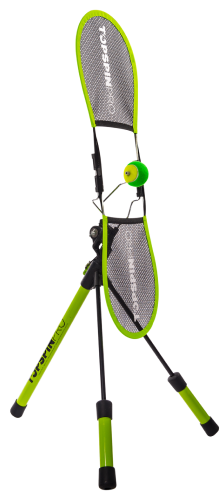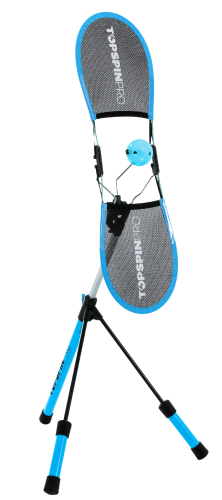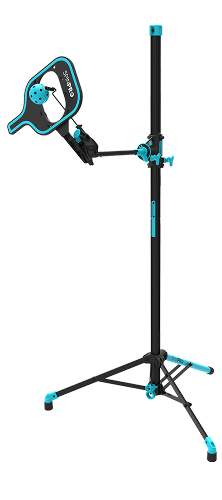
What we'll cover in this article:
Stay in the loop!
Want to be updated when we publish? Be sure to sign up for our newsletter. No spam, we promise!
Why Hit Deep?
For the purposes of this article, we will focus on singles play but the structure and theory are very similar on the doubles court! The number one goal of tennis is to keep the ball in the court one more time than your opponent! The second most important goal is to keep your opponent off the tennis court. What I mean by that is that if your opponent is inside of the baseline it is much easier for them to attack. See the image below. So effectively you want to keep your opponent off the court at the back and also the sides. When a player is off the court to the sides they are generally still in the defensive zone or maybe neutral.

As shown in the image above, forcing your opponent to hit from the defensive zone increases their chances of making a mistake. When pushed back, they're often off balance or leaning back, leading to errors. Players frequently hit long from this position, or in an attempt to overcompensate for a high, deep ball, they may hit down on it, sending it into the net or landing it short in your attack zone.
Here’s why depth is so important:
Gives You More Time
Depth not only pressures your opponent but also gives you extra time to position yourself for the next shot or to anticipate their response. This added time can be crucial when you're feeling under pressure or need to slow down the rally by hitting higher, looped balls.
Reduces Opponent’s Power
When you hit deep it’s harder for them to step into the ball and use their body weight to generate power. They’re also more likely to hit short, setting you up in your attack zone.
Limits Opponent’s Angles
By hitting deep, you reduce your opponent's ability to create angles. When they’re pushed back near the baseline, it’s harder for them to hit sharp cross-court angles. They’ll be forced to hit safer, more defensive shots, allowing you to control the point.
Forces Defensive Play
When your opponent is hitting from deep behind the baseline, their only option is often a defensive or neutral shot. Deep balls are hard to attack, which can result in weaker returns, allowing you to step inside the court and go on the offensive. Many players also get overwhelmed by heavy topspin. If you can add a good amount of topspin to your deep shots you can force an error very quickly.
Depth vs. Power
While power can be impressive, it's often overvalued, with many players focusing on speed rather than consistency. However, power alone doesn't always translate into winning points. Power is most effective when you have a clear opportunity to finish the point, typically in the "finish zone."
Here’s how depth stacks up against power in key aspects of the game:
Consistency
Power shots, especially when hit with little topspin, have a higher risk of going long or wide. A player relying solely on power might make more unforced errors, especially under pressure. Deep shots, however, are more consistent because you can add topspin to control the height and trajectory of the ball, ensuring it stays in play while still forcing your opponent into a difficult position. Keep that ball in the court one more time than your opponent most of the time and you win!
Moving Your Opponent
Power often forces the ball into short rallies, as players go for quick winners. Depending on your situation, depth allows you to play longer rallies and gradually wear down your opponent. You can try to be more consistent than them and move them around the court, making them work for every point. This also opens up opportunities to attack in more consistent ways.
Recovery Time
When you hit with depth, the ball takes longer to reach your opponent. This extra time allows you to recover your positioning on the court, ensuring you’re ready for the next shot. In contrast, hitting a hard, flat shot might give your opponent less reaction time, but it also limits your recovery window, especially if the shot is returned quickly. Make your choices wisely depending on what situation you are in. If you are tired, give yourself a little more time.
How to Improve Deep Groundstrokes
Like any other shot or tactic in tennis, improving depth takes practice and focus. Here are some tips to help you develop consistent deep groundstrokes:
Apply Topspin
Topspin is crucial for controlling depth. It allows you to hit the ball higher over the net and with a little more pace while still keeping it within the court. The topspin causes the ball to dip as it travels. Here's an in-depth guide to topspin.
If you are new to topspin then one of the best ways to learn the biomechanics is to use a TopspinPro. This is an easy and fast way to master topspin at home.
Aim Higher Over the Net
To hit the ball deep, aim for a higher trajectory. This gives the ball more time to travel and ensures it lands closer to the baseline. A general rule is to aim 3 to 6 feet above the net when trying to hit deep. Experiment with different heights to find the right balance between depth and pace.
Here's a drill that can help you combine the use of topspin and height:


Work On Consistency
Add zones to the court like in the image above or mark out a defensive zone section and see if you can get the ball landing deep. Generally, a ball that lands in the neutral zone will force the player to hit it in the defensive zone. So try to aim within the back 4-5 feet of the court. If you can do this consistently both with feeds and in a rally then you know you mastering depth.
Practice Hitting Targets
To take your depth control to the next level it's good to practice being more precise and not just hitting past a certain line. If you can hit deep but place the ball from side to side etc or consistently to the backhand side then you are going to pressure your opponent well. Place cones or markers near the baseline in different areas to aim for.
Practice Under Pressure
It's all well and good becoming consistent in practice, but when you are under pressure in a match can you still hit the same way? It's important to practice in a matchplay-style scenario. You can also use fun pressure-inducing games with your training partners by having cone-hitting challenges. Another great game is to play out points but only in the back half of the court. This adds instant pressure!
TOPSPINPRO BEGINNER COURSES
We use the latest neuroscience in our TopspinPro Online Courses. Check them out for some in-depth help with developing your shots:
When to Hit Depth Vs. Power
Understanding when to focus on depth instead of power is key to controlling a match. Here are some scenarios where deep groundstrokes are the better choice:
During Neutral Baseline Rallies
I always tell my students, if they are going to miss, make sure it's a forced error. If you can stay consistent when you are in a neutral position and keep the ball deep, you can shift the situation in your favor either by forcing a mistake or by moving your opponent from neutral to defensive.
When Defending
If you’re on the defensive or being pushed around the court, hitting deep can neutralize your opponent’s attack. Deep balls buy you time to recover and reset the rally.
Here's a video explaining a little more:


When Building a Point
If you’re working to open up the court and create space for a winning shot, depth helps to gradually move your opponent back. Once they’re behind the baseline, you can attack with angles or a drop shot.
Against Aggressive Players
When facing an aggressive player who likes to move forward and hit with power, hitting deep can prevent them from taking control. It forces them to stay back and hit from uncomfortable positions, often leading to errors. You can also use a moon ball technique and take the pace off the ball. This often frustrates aggressive baseliners because they have not pace to work with and at the same time are pushed back!
Conclusion
Depth in tennis is often underestimated, but it’s a critical component of controlling the game. While power has its place, deep groundstrokes allow you to dictate rallies, limit your opponent’s options, and set up for winning shots. By developing consistency, using topspin, and focusing on placement, you can make depth a core part of your strategy and elevate your game to the next level. Remember, tennis is about strategy as much as it is about power, and mastering depth will give you a significant edge in any match.
FAQs
-
Why is hitting deep important in tennis?
Hitting deep is crucial because it keeps your opponent off the court, making it harder for them to attack. This forces them into a defensive position, increasing the likelihood of mistakes.
-
How does hitting deep give you more time during a match?
Hitting deep provides you with extra time to get into position for your next shot or to anticipate your opponent’s shot. This is especially useful when you’re feeling pressured and need to slow down the rally.
-
What are the benefits of hitting deep versus hitting with power?
Hitting deep offers consistency, control, and more recovery time, while power can lead to unforced errors and shorter rallies. Depth allows you to outmaneuver your opponent and set up winning shots more effectively.
-
How can you improve your deep groundstrokes?
To improve deep groundstrokes, focus on applying topspin, aiming higher over the net, and practicing hitting targets. Consistency and practicing under pressure are also key to mastering depth.
-
When should you focus on depth rather than power in a match?
Focus on depth during neutral baseline rallies, when defending, when building a point, and against aggressive players. Deep shots can neutralize your opponent’s attack and create opportunities for you to take control.
Links Related to This Article
Enjoyed this article?
Be sure to sign up for our newsletter and we'll keep you up to date about new posts



